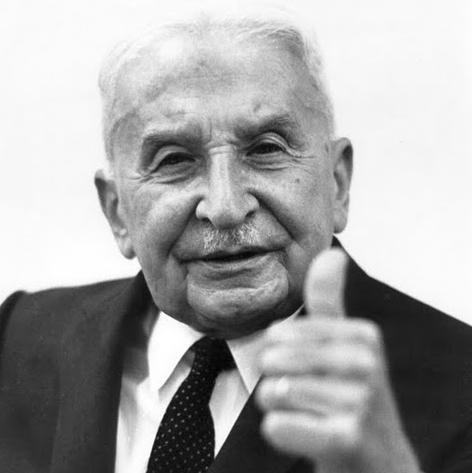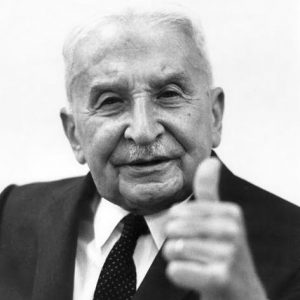Ep. 31 Capital & Interest in the Austrian Tradition, Part 3 of 3

 Bob finishes his 3-part series by first reviewing the contributions of Bohm-Bawerk, Fetter, and Mises to the modern Austrian explanation of interest, namely the “pure time preference theory” (PTPT). Then Bob explains some of the problems for the PTPT, especially for Austrian economists. Instead Murphy offers a much more straightforward–and Austrian!–approach, which explains interest as the premium placed on present vs. future units of money.
Bob finishes his 3-part series by first reviewing the contributions of Bohm-Bawerk, Fetter, and Mises to the modern Austrian explanation of interest, namely the “pure time preference theory” (PTPT). Then Bob explains some of the problems for the PTPT, especially for Austrian economists. Instead Murphy offers a much more straightforward–and Austrian!–approach, which explains interest as the premium placed on present vs. future units of money.Mentioned in the Episode and Other Links of Interest:
- Part 1 and Part 2 in this series (BMS ep. 26 and 28).
- Bob’s doctoral dissertation, in which the second and third essays elaborate on the main elements of this episode.
- Eduard Braun’s article explaining how Carl Menger changed his view on capital. (Thanks to Ryan Griggs.)
- Use Bob’s special link to subscribe to Liberty Classroom, where (among other courses) you can get Bob’s two courses on the History of Economic Thought.
- Bob’s book (co-authored with Nelson Nash and Carlos Lara) The Case for IBC, which explains the Infinite Banking Concept.
- Help support the Bob Murphy Show.
The audio production for this episode was provided by Podsworth Media.

[…] Part 3 of 3 of my scintillating series on Capital & Interest. In this one, I take aim at Bohm-Bawerk, […]
Now, if you die tomorrow, at least you’ll have made these three podcast episodes. Here’s to hoping this one is as good as the last two.
I still dont understand the difference between naive productivity theory and the mainstream Keynesian theory of interest, though. Also, I do want to know the problems with the marxist exploitation theory of interest. You stated on Contra Krugman that it would imply that more labor intensive fields would be more profitable than capital intensive fields. However, couldnt capital make it easier for capitalists to exploit labor, extracting more money per labor hour, explaining why machinery tends to increase profit margins? After all, if the labor was all done by robots with no wage, that could be considered 100% exploitation.
But alas, there will be no part 4 of 3 addressing every minute question I have.
Hi Matt,
Thanks for the note. Regarding BB’s critique of Marx, try this.
I would argue that a primitive barter economy might have legitimate time preference. Some hunter might readily decide to eat this much meat today … and then trade some meat in exchange for salt and preserve a certain proportion of meat in the salt to eat another day, and to make sure some of the women in the tribe get a share of the meat so they will see him as a provider and improve his status in the tribe. That’s all economic calculation, and there’s an element of consume now vs consume later judgement involved.
You will run into the limitation that you can’t come up with a neat interest rate in terms of per annum percentage, dividing one thing by another thing, unless you can reduce it back to personal hours of effort or something like that. Even then it would not be “pure” … like a pure time preference.
Now here’s a point that ties up most of the ideas in your talk and which you seem to have skipped entirely: you say that proper interest rates can only exist if we look at money. That is there’s something special about money which allows you to extract additional information that you would not have access to in a simple barter situation. Then you go through the difficult case of whether someone who is in Winter time, asked if they would prefer more ice in the middle of Winter (when it’s kind of useless) or ice in the middle of Summer (when it’s more useful). You end up getting weird time preference values out of this, like perhaps negative interest rates.
OK, let’s put this together. What’s the key issue that makes ice special? What makes money special? We already know these answers.
Go back to the primitive barter society … over time money usually tends to “emerge” out of these societies in the form of some kind of trade goods, whether that be stone axes or bronze knives, then eventually standardized gold and silver coins. The physical properties that make one commodity preferable as a choice of money are:
* It has a widely accepted value, thus a big network effect.
* Easy to assay, and standard sizes, thus good for accounting.
* Can be subdivided if necessary.
* Reasonably portable.
* Good store of value, thus does not degrade over time.
Not many societies will start using snowmen as money because they fail on every point. Most importantly, it is difficult to move the snowman around and you have nowhere to put it during the Summer. Oh wait … that’s the same problem we are running into with time preference and negative rates. The reason ice in Winter isn’t such an attractive acquisition is precisely because ice is not a good store of value … you have to put work into keeping that same ice through to the Summer.
Then we get back to the question of interest rates, and money, but the answer is the converse: people find economic calculation easier to do when using money for that calculation because the storage issue can simply be ignored. The zero interest rate lower bound applies to money because of the zero storage cost … you put money in your pocket today and it comes out the same money next week or next year. That’s not true for ice!!
I’m never worse off getting paid in money today than I am getting paid the same amount of money next year … because I can easily just store the money for when I need it. That’s not true for ice!! OK, fiat money does degrade over time because of inflation … that’s something of a modern affliction … and it allows for negative interest rates in real terms. Gold and silver coins in your pocket won’t be subject to inflation, so the closer to ideal money you can achieve the more reliable is your zero lower bound interest rate. We can argue about the political implications of that elsewhere, I’m only looking at the fundamental principle here.
In summary, whatever a society does choose to use for money, that commodity will hold a privileged position in terms of the calculation of interest rates for exactly the same reason that it was chosen for money in the first place.
The three part series is a lot to digest (in a good way). I think I’ll need to listen to each one again, take a break, and listen again. I appreciate all you do.
Hey Bob, I think I understood most all of what you explained, but only one thing I did not get: what’s special about money? Is money not simply just another market good? This, following the idea that money is actually just a good that has some specific characteristics. What makes it different with regards to interest?
I just listened to and enjoyed very much this three part series. It made me think more about capital theory than is probably good for my brain. I also read Bob’s dissertation which I also enjoyed.
However I ended up not getting why a single good mo0del cannot be used to demonstrate Bohm Bawerk’s theory. Here’s my logic.
Assume an economy with the following attributes:
– A fixed labor supply
– Free raw materials and land
– The capacity to produce only 1 good that can either be consumed or saved. If it is saved it become capital
– The more capital possessed by this economy the greater its productivity
– However as more capital is added productivity increases at a diminishing rate.
– Adding capital is the only way of increasing productivity
– People in the economy have positive time preference
In this economy any units of the single good that are saved will lead to higher productivity the next period. As there are diminishing returns to scale the economy will expand until the point where the additional productivity gained from saving a unit of the good is equal to the equilibrium rate of time preference in this economy.
At that point both the marginal physical productivity and the interest rate will be equal.
However if one drops the assumption about falling marginal productivity of capital and assumes constant returns (say 10%) then I believe that the amount of capital will expand until the economy as a whole is indifferent between the 10% extra output from saving one additional unit of the good and consuming the unit in the current period. At least in this case (as Bob points out) interest rates are determined by physical productivity.
I think this single good model can be applied to the real world of diverse consumer and capital goods. The simplest way to do this is to think of the economy as a “utility generating engine”. All goods are essentially embodied utility. If the good is consumed in the present period it can be classified as a consumer good and if not a capital good. Just as in the single good model if there are diminishing returns to adding capital to a fixed labor supply then capital will be added until its physical output of embodied utility matches societal time preference and this will be the prevailing interest rate. In the unlikely event that all capital goods in this model have constant returns to scale then it will be this constant rate of return that will be the interest rate (to avoid arbitrage opportunities) and the capital structure will expand until at the margin the economy is indifferent between consuming a unit of output now and the additional units in the next period from saving that unit.
I’m sure much of the above is confused or just plain wrong but welcome any feedback.